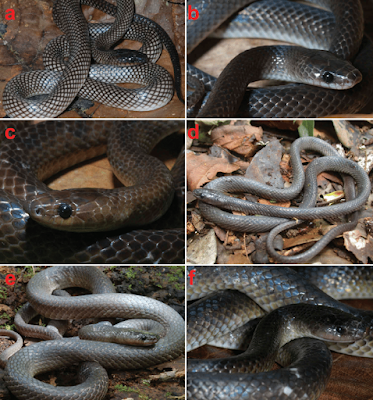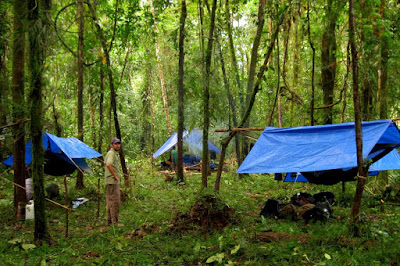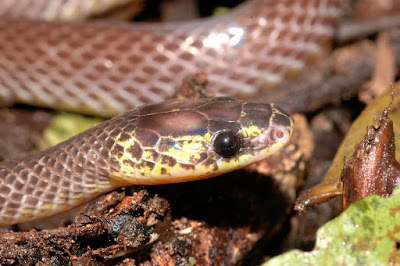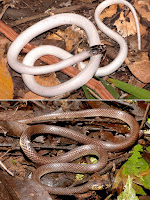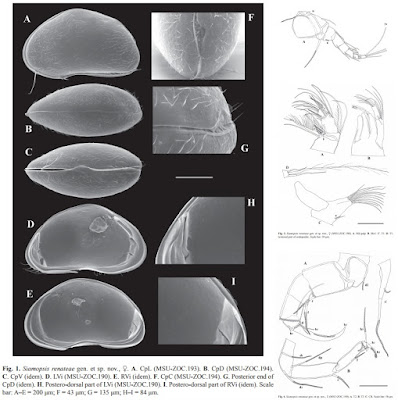[Most Recent Entries] [Calendar View]
Monday, December 25th, 2017
| Time | Event | ||||||||
| 1:30a | [Herpetology • 2017] Cryptic and Non-Cryptic Diversity in New Guinea Ground Snakes of the Genus Stegonotus Duméril, Bibron and Duméril, 1854 (Squamata: Colubridae): A Description of Four New Species
ABSTRACT The island of New Guinea has been identified as biologically megadiverse but many taxa are still poorly known. This is especially the case for many of the island’s snakes, which by their very nature can be difficult to collect and study. Here we examine the phylogenetic and phylogeographic structure of a poorly studied snake genus, Stegonotus, focusing on the species of New Guinea; until now, Stegonotus has never been examined using modern phylogenetic methods. Using molecular data from 49 individuals representing eight of the ten described species, and including all New Guinea taxa, we estimate a multilocus phylogeny and examine population structure to help identify undescribed taxa. We use morphological data from the corresponding museum vouchered specimens (where available) and also examine additional specimens for taxa not included in the molecular data set to determine morphological differences among putative taxa. We find molecular evidence for four new species of Stegonotus, both morphologically obvious and cryptic, and describe them herein. The recognition of these four species indicates that Stegonotus diversity has been previously underestimated and also suggests that there are likely additional undescribed taxa within the genus. These four taxa increase the number of described species by 40% and further confirm New Guinea as the centre of diversity for the genus. KEYWORDS: Australasia, colubrine, Indonesia, integrative taxonomy, phylogenetics
Stegonotus iridis sp. nov. Etymology: The species epithet is a noun in apposition and taken from the Latin word for rainbow. It refers to the high level of iridescence shown both dorsally and ventrally by this species. Natural history and distribution: Currently known only from the Raja Ampat islands of Batanta, Salawati and Waigeo in eastern Indonesia where all of the animals encountered were active on the forest floor in moderately to heavily disturbed lowland (< 100 m asl) rainforest at night. The pale colour of this species made them extremely conspicuous against the dark forest floor.
Stegonotus derooijae sp. nov. Etymology: The species epithet is a noun in the genitive case and is a patronym in honour of Dr Nelly De Rooij, who described many taxa from New Guinea and Indonesia, including Stegonotus florensis. Natural history and distribution: Currently known only from the Raja Ampat islands of Batanta, Salawati and Waigeo in eastern Indonesia. This small, slender species was active on the forest floor in moderately to heavily disturbed lowland (< 100 m above sea level) rainforest at night. At each site it occurred in sympatry with S. iridis sp. nov., described above. Stegonotus melanolabiatus sp. nov. Etymology: The species epithet comes from the Greek melano meaning black or dark and the Latin word labia for lips. The name refers to the dark coloration of the labial scales of this species. Natural history and distribution: No information is known about the natural history of S. melanolabiatus. Stegonotus melanolabiatus sp. nov. is found south of the central mountain ranges (Figure 3) in Southern Highlands and Chimbu Provinces of Papua New Guinea. It may also occur in other provinces and regions south of the central cordillera across New Guinea. Stegonotus admiraltiensis sp. nov. Etymology: The species epithet refers to the Admiralty Islands where this species is found, an archipelago of 18 islands to the north of New Guinea, comprising Manus Province, Papua New Guinea. Natural history and distribution: As with all New Guinea Stegonotus, S. admiraltiensis sp. nov. is nocturnal. All four specimens were collected at night as they were moving on the forest floor on the leaf litter. Typical for Stegonotus, once picked up S. admiraltiensis sp. nov. rapidly attempted to bite the collector’s hand and writhed violently in a side-to-side motion. Nothing more is known about the natural history or ecology of S. admiraltiensis sp. nov. Stegonotus admiraltiensis sp. nov. is found on the islands of Rambutyo and Los Negros in Manus Province of Papua New Guinea. Based on descriptions of similar specimens from Manus (McDowell 1972) and recent collections there by SJR that will be registered in the near future (Richards and Aplin 2015), we conclude that S. admiraltiensis sp. nov. is also found on Manus Island proper and that all specimens of Stegonotus from the Admiralty Islands are S. admiraltiensis sp. nov. Sara Ruane, Stephen J. Richards, John D. McVay, Burhan Tjaturadi, Keliopas Krey and Christopher C. Austin. 2017. Cryptic and Non-Cryptic Diversity in New Guinea Ground Snakes of the Genus Stegonotus Duméril, Bibron and Duméril, 1854: A Description of Four New Species (Squamata: Colubridae). Journal of Natural History. DOI: 10.1080/00222933.2017.1391959 ResearchGate.net/publication/321315773_N sararuane.wordpress.com/about/publicatio Naming a New Guinea Snake Species, Honoring a Legacy http://lsuscienceblog.squarespace.com/bl twitter.com/@Sara_and_Snakes/status/9355 | ||||||||
| 2:00a | [Crustacea • 2017] Teretamon spelaeum • A New Species of Freshwater Crab (Decapoda: Potamidae) from A Limestone Cave in Meghalaya, India
Abstract A new species of freshwater crab of the genus Teretamon Yeo & Ng, 2007 is described based on material collected from a limestone cave state of Meghalaya, in the northeastern Himalayan region of India. Teretamon spelaeum n. sp. can easily be distinguished from its congeners by a well suite of carapace and gonopod characters: a relatively wider carapace, setose chelipeds and legs, a highly reduced cornea of the eye, and a diagnostic male first gonopod that has a low rounded median dorsal flap on the terminal joint. The morphology of the new species is clearly adapted for the cave dwelling and is the first true troglobitic freshwater crab known from India. Keywords: Crustacea, Potamidae, Teretamon, taxonomy, new species, Meghalaya, India Teretamon spelaeum n. sp. Etymology. The name refers to the habitat of this species, derived from the Latin, spelaeum, meaning cave. The name is used as a noun in apposition. Geographical distribution. Teretamon spelaeum is known only from the type locality, the Krem khung cave of Meghalaya state of India. Parveen Farzana Absar, Santanu Mitra and Ilona J.Kharkongor. 2017. Teretamon spelaeum, A New Species of Freshwater Crab (Crustacea: Decapoda: Potamidae) from A Limestone Cave in Meghalaya, India. Zootaxa. 4365(3); 302–310. DOI: 10.11646/zootaxa.4365.3.2 Young scientist discovers new species of crabs in Meghalaya | The Third Pole thethirdpole.net/2017/05/17/young-scient | ||||||||
| 3:26a | [Crustacea • 2017] Siamopsis gen. nov. and Five New Species of the Subfamily Cypridopsinae Kaufmann, 1900 (Ostracoda) from Thailand
Abstract Siamopsis gen. nov., described here, belongs to a group of genera with the right valve overlapping the left valve in the subfamily Cypridopsinae Kaufmann, 1900 of the family Cyprididae Baird, 1845. The distinguishing characters of the new genus are in the morphology of its valves and soft parts. The postero-dorsal margin of the internal left valve is plate-like protruded. The morphology of this plate varies in different species, e.g., some species bear a tooth-like tubercle on the plate. The posterior margin of the right valve is recurved inwardly at ca mid-height, resulting in the occurrence of a lobe-like expansion that can clearly be seen in the dorsal and caudal views of the carapace. In addition, the other diagnostic soft part features of the new genus are the cylindrical caudal ramus, the presence of two t-setae on the female A2 penultimate segment, the very elongated terminal segment of the Mx1 palp, the morphology of the two large bristles (tooth bristles) of the Mx1 third endite (one smooth, one serrated) and the absence of d-seta on T1. In the present paper, five new species are described under this new genus: Siamopsis renateae gen. et sp. nov., S. suttajiti gen. et sp. nov., S. conspecta gen. et sp. nov., S. khoratensis gen. et sp. nov. and Siamopsis planitia gen. et sp. nov. A key to the species of Siamopsis gen. nov. is also provided. Keywords: Cypridopsinae; biodiversity; taxonomy; new species; Thailand Class Ostracoda Latreille, 1802 Subclass Podocopa G.O. Sars, 1866 Order Podocopida G.O. Sars, 1866 Suborder Cypridocopina Jones, 1901 Superfamily Cypridoidea Baird, 1845 Family Cyprididae Baird, 1845 Subfamily Cypridopsinae Kaufmann, 1900 Siamopsis gen. nov. Type species: Siamopsis renateae gen. et sp. nov. (here designated) Diagnosis: RV overlapping LV anteriorly, ventrally and posteriorly. LV in internal view with postero-dorsal plate. Posterior margin of RV recurved inwardly. Wouters organ on A1 present, aesthetasc ya long. Terminal segment of Mx1 palp cylindrical, very elongated (length > 2 × width). A2 with well developed claws, long natatory setae, with two t-setae in females. T1 with a-setae (b, c and d setae absent). T2 with d2 seta (d1 seta absent). CR reduced, fl agellum-like, cylindrical in shape. Etymology: The genus is named after the country “Siam”, the former name of Thailand, where the new taxa were discovered. The name is combined with the suffix of the existing generic name Cypridopsis. Differential diagnosis Siamopsis gen. nov. can be distinguished from other genera of the subfamily Cypridopsinae by the presence of a postero-dorsal internal plate of the LV and the morphology of the posterior inner valve margin of the RV, which is recurved inwardly. Additionally, it differs from its closest genus, Plesiocypridopsis Rome, 1965, by the presence of the A1 Wouters organ, the two t-setae of the female A2 (there are four t-setae in Plesiocypridopsis) and the morphology of the two large bristles (teeth bristles) on the Mx1 third endite, of which one bristle is smooth while the other one is serrated (both setae are serrated in Plesiocypridopsis). Species included Siamopsis renateae gen. et sp. nov., S. suttajiti gen. et sp. nov., S. conspecta gen. et sp. nov., S. khoratensis gen. et sp. nov., S. planitia gen. et sp. nov. Distribution: Thailand (present study). Siamopsis renateae gen. et sp. nov. Etymology This species is named after Dr. Renate Matzke-Karasz (Munich University, Germany) in appreciation of her outstanding work on ostracods and also for a long friendship. Type locality: THAILAND: Nakhon Ratchasima Province, Muang District, irrigation ditch ..., 5 Oct. 2010. Accompanying ostracod fauna: Cypris subglobosa Sowerby, 1840, Cyprinotus uenoi Brehm, 1936, Stenocypris cf. orientalis Victor & Fernando, 1981, Siamopsis khoratensis gen. et sp. nov., S. conspecta gen. et sp. nov. and S. planitia gen. et sp. nov. Ecology The new species has thus far been recorded from eight localities in the Northern and Northeastern provinces: Nakhon Ratchasima, Chaiyaphum, Phayao, Chiang Rai, Phitsanulok and Phetchabun. It occurs at a pH range of 6.5–7.2, a temperature range of 26.1–29.5°C and a dissolved oxygen (DO) range of 3.20–7.80 mg/l. Siamopsis suttajiti gen. et sp. nov. Etymology: This species is named after Prof. Dr. Maitree Suttajit (University of Phayao, Thailand) in appreciation of his encouragement and moral support over the years, especially during my research project on nonmarine ostracods in the southern part of Northeast Thailand. Siamopsis conspecta gen. et sp. nov. Etymology: The Latin word ‘conspecta’, meaning conspicuous, refers to the markedly well-developed tooth-like tubercle on the postero-dorsal plate of internal LV. This is the most prominent character of the new species. Siamopsis khoratensis gen. et sp. nov. Etymology: The species is named after Nakhon Ratchasima Province, also called “Khorat”, where the new species was discovered. Siamopsis planitia gen. et sp. nov. Etymology: The specific epithet “planitia” refers to the appearance of a dorsal margin at the middle part of the carapace in lateral view, which is similar to the summit of a plateau. This is the most prominent character of the new species. Sukonthip Savatenalinton. 2017. Siamopsis gen. nov. and Five New Species of the Subfamily Cypridopsinae Kaufmann, 1900 (Crustacea: Ostracoda) from Thailand. European Journal of Taxonomy. 384; 1–39. DOI: 10.5852/ejt.2017.384 |
| << Previous Day |
2017/12/25 [Calendar] |
Next Day >> |

